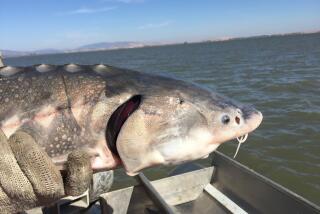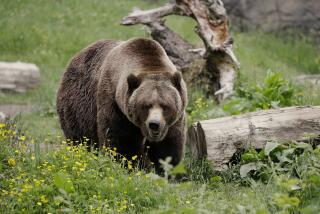U.S. May Bump Montana Grizzlies Off Protected List
- Share via
The head of the U.S. Fish and Wildlife Service has declared that grizzly bears are no longer a threatened species in the northern Rocky Mountains and has taken the first steps to remove the bears in that region from the protection of the Endangered Species Act.
Removing the grizzly bear from the list of threatened species would open hundreds of thousands of acres of federal lands in the bears’ habitat to potential oil and gas exploration. It would also turn jurisdiction over the bears to the state of Montana, where ranchers have complained that grizzlies prey on their livestock.
The action by U.S. Fish and Wildlife Service Director Frank Dunkle, announced Thursday at a little-noticed meeting of a nonprofit foundation that backs oil and gas exploration in Montana, drew sharp protests from environmentalists on Friday.
“The grizzly populations (in the northern Rockies) show a good healthy trend upward,” Dunkle said in a telephone interview Friday. He said the Endangered Species Act provides for lifting protection of threatened animals when populations stabilize above critical levels.
Dunkle said he was basing his decision on bear population estimates provided by the state of Montana.
Dunkle’s order involves only an estimated 500 to 800 grizzlies roaming the northern Continental Divide ecosystem, which stretches south from the Canadian border through Glacier National Park, the Bob Marshall Wilderness and other federal lands along the eastern flank of the Rocky Mountains in north-central Montana. The 300 or so grizzlies in the Yellowstone ecosystem, near Yellowstone National Park to the south and west, would remain under the protection of the federal act, Dunkle said.
Wildlife experts estimate that there are fewer than 1,500 grizzly bears in the lower 48 states. At this time they are classified as “threatened” under the Endangered Species Act, a classification that permits killing an animal only when it threatens life or property. Grizzlies are considered numerous enough in Alaska and Canada to not be listed as threatened there.
Stand Up to 8 Feet Tall
Grizzlies stand up to eight feet tall on their hind legs and weigh up to 800 pounds. Once they roamed from the Mississippi to California and Mexico to Alaska. Killed off by hunters and ranchers, their numbers dwindled until only a few hundred remained within the Rocky Mountains, where scientists say breeding females produce a cub or two every two or three years.
Removal of the grizzly from the protection of the act is a lengthy process that Dunkle estimated could take a year or more. To take an animal off the list, the law requires that Fish and Wildlife experts prove the species is out of danger and recovering. In the grizzly’s case, the arguments will focus on how much data is needed to prove that they are thriving and how soon that information can be obtained.
If the northern grizzlies are ultimately removed from the list by Interior Secretary Donald P. Hodel--a decision that Hodel will not face until Dunkle makes a formal request for such action--jurisdiction over the bears would be returned to the state. Montana could then allow the bears to be hunted and could authorize logging, oil and gas exploration in grizzly habitat areas that are now restricted to protect the bear.
Dunkle announced his intention to remove the bear from the protection list in a speech to the Montana Overthrust Energy Foundation in Great Falls. The foundation favors “responsible” development of oil and gas reserves, according to its president, Keith Haugland, marketing director for the Great Falls Tribune.
Haugland predicted that if the bear is removed from the list the oil and gas industry “would have no problem following grizzly bear restrictions” imposed by the state to protect bear habitat while exploring petroleum reserves. By taking the bear off the federal protection lists, he estimated, another 600,000 acres of federal lands would be available for exploration. Dunkle could not confirm the precise number of acres involved.
News of Dunkle’s action brought an immediate response from environmentalists and wildlife protection groups.
Longstanding Controversy
“Now the jury is in on Mr. Dunkle; wildlife has no defender in (the Reagan) Administration,” said Joyce M. Kelly, president of Defenders of Wildlife. George T. Frampton Jr., president of the Wilderness Society, said removing the bear from the protective action would “consign it to extinction across a substantial portion of its range in the lower 48 states. . . . The Interior Department is again acting as an advocate for the oil and gas industry.”
There is a longstanding controversy over oil and gas exploration on federal lands along the eastern flank of the Rockies. Currently, lands designated as critical grizzly habitat in the national forests are excluded from mineral exploration. Livestock men also favor removing the bear’s protected status, contending that grizzlies prey on their sheep with impunity. Currently, ranchers are permitted to kill a bear only if it is caught killing livestock.
Dunkle, a former Montana state wildlife official, said Montana officials initiated the move to lift restrictions on the bear. “I’ve written our regional director directing him to open delisting discussions with Montana,” he said.
“There is no reason for the grizzly to be on the threatened list in the northern ecosystem,” said James Flynn, director of the Montana Department of Fish, Wildlife and Parks. A department study shows that the recovery plan goals for the grizzly set at the time the bear was put on the federal list “have been met and the bear is now in a position to be considered for delisting,” he said.
Flynn said state wildlife biologists reviewed data gathered over a number of years by various agencies and then sampled a small number of bears along the ecosystem’s eastside, outside Glacier National Park. He did not know the number of bears sampled or the details of the findings, but he said, “We’ve always felt the northern populations have not been threatened.”
He estimated the total ecosystem population at around 800 bears, a higher estimate than that of the National Park Service or federal fish and wildlife experts.
A multiagency study of the bear population is currently under way. The study, which includes the Fish and Wildlife Service, is not expected to be completed for three to six years.
Move Called Premature
Alan O’Neill, Glacier National Park assistant superintendent, described as “premature” the effort to remove the grizzly from the protected list.
“There are no hard facts on the numbers and trends in bear populations,” he said. “There are real questions about the number of productive females, for example.”
He said preliminary reports from the inter-agency study show from 53 to 79 productive females in the northern ecosystem. Those numbers are based on extrapolation from small samples, not a comprehensive census, he added.
“There is too much uncertainty. If they are removed from the list, what will happen to their habitat if all of the development projects on the books take place? Our feeling is that we will lose critical bear habitat,” O’Neill said.”
More to Read
Sign up for Essential California
The most important California stories and recommendations in your inbox every morning.
You may occasionally receive promotional content from the Los Angeles Times.










